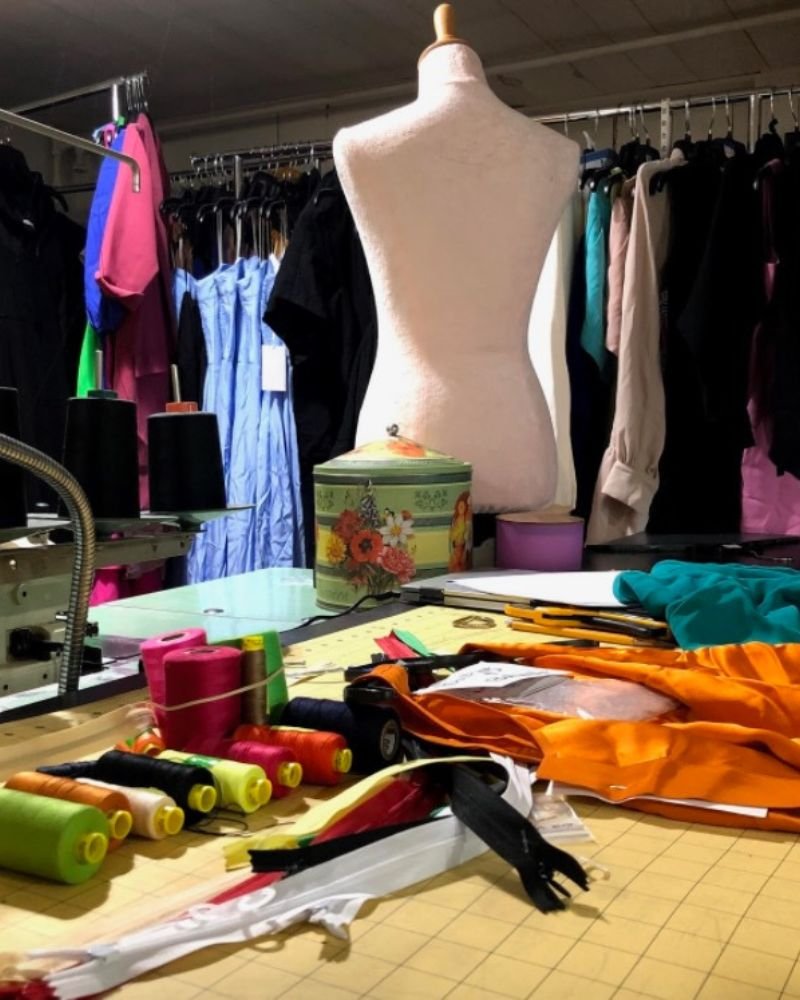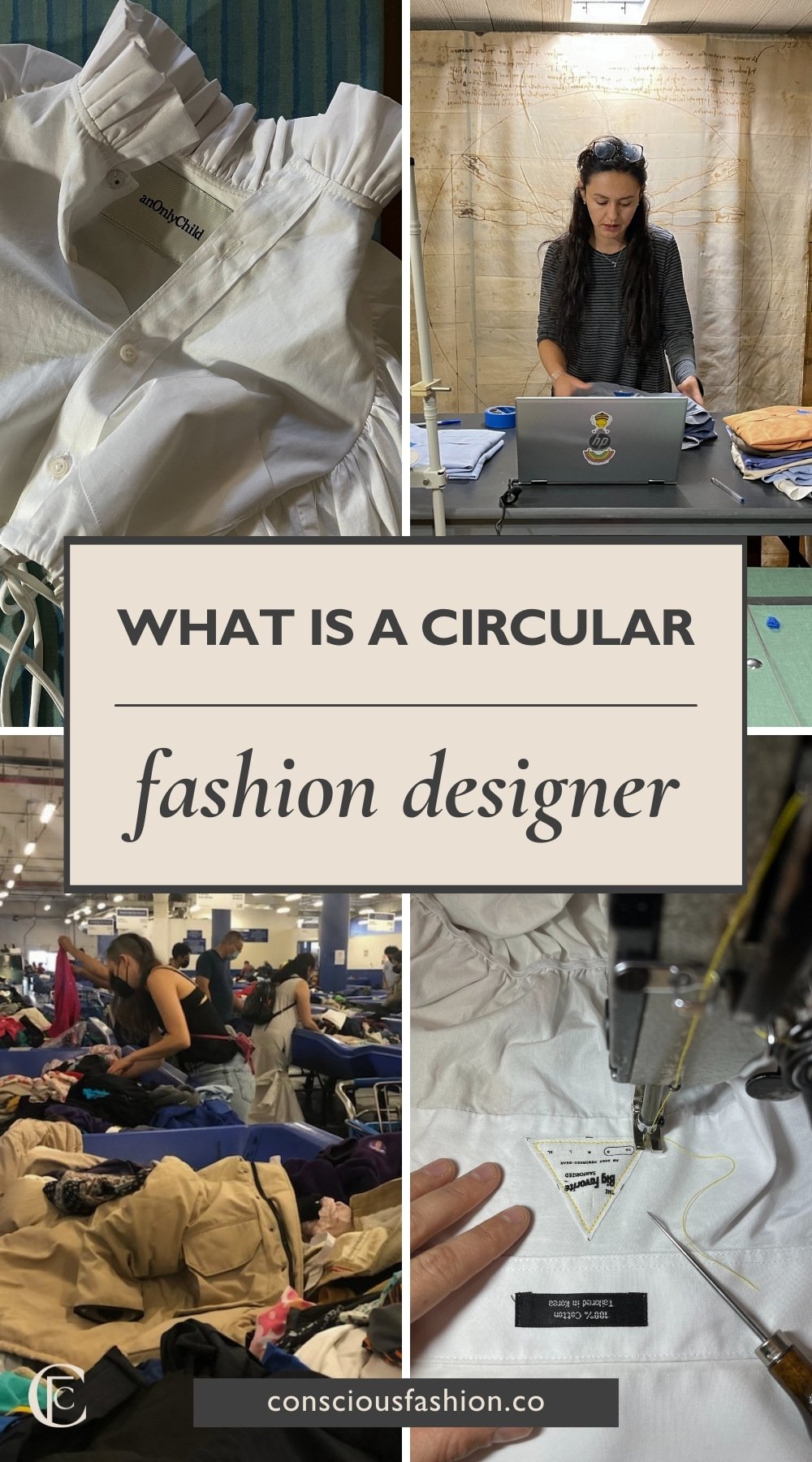How This Circular Fashion Designer Is Reshaping The Linear Clothing System
Conscious Career Chats Series
by Stella Hertantyo
image courtesy of MAKE ANEEW
What if we considered the end of a garment’s lifecycle from before it even came into existence?
Fashion waste begins as soon as a garment is conceptualized. This is because how a garment is designed, the intentions behind it, and the fabrication are all decisions made before a garment comes to exist. So, most often, waste is a design or production flaw.
For example in the fast fashion industry, the intention is that a garment will be bought quickly, worn for a short period, and then disposed of. So these garments are not designed to last. This is what is known as the linear take-make-waste economy.
But this take-make-waste economy has created fashion's waste crisis.
Circular fashion has arisen as an antidote. It champions an alternative economic logic — echoing nature’s processes — that everything we make has to return to the earth and so aims to keep resources in circulation for as long as possible.
What is Circular Design?
image courtesy of MAKE ANEEW
Circular fashion design is an approach to developing garments and systems that incorporate three key circular economy principles: designing out waste, keeping materials and products in use, and regenerating natural systems.
Courtney Holm, circular fashion design consultant, educator, and founder of Australian circular fashion brand A.BCH shares that at her brand, in practice, this looks like:
Using 100% regenerative and biologically circular inputs for all their clothing
Researching, developing, testing, and creating products for longevity, repair, and remanufacture
Tracking, reducing, and eliminating material and energy waste in the industrial, manufacturing, and post-consumer lifecycle phases
Providing communications, extended care, and producer responsibility information for all items they make
Circular design is not just about preparing garments for recycling, but about reducing resource use and ensuring that garments are worn for as long as possible, in multiple lifecycles before they need to be disposed of. It’s a design practice, but also a cultural shift.
What is the role of a circular fashion designer?
Circular fashion designers conceptualize products and garments that aim to design out waste and keep materials in use for as long as possible.
“There are many steps a designer can take to implement circular practices now that don’t require waiting around for chemical recycling advancements or the latest biomaterial innovation,” says Holm of A.BCH.
“Textile recycling should be the last step, because it uses a lot of energy to turn secondhand garments into new textiles,” elaborates Carmen Gama, circular systems designer and Co-Founder of MAKE ANEEW.
This could mean designing with fabric waste, upcycling discarded materials, incorporating recycled or compostable materials, working with regeneratively farmed fibers, and creating garments that are durable and easy to disassemble and recycle at end of life.
“As a circular designer, you need to ensure that you have embedded a second, third, or fourth life into the design of your garment so that at end-of-life those materials can go back into your supply chain and create something new. You’re not extracting new material from our planet, instead, you are working in a continuous loop,” says Gama.
If you’re curious to learn more about how circular fashion design can be a force for good and how to get into the business of waste, read Carmen Gama’s career story below.
Carmen Gama
image courtesy of Carmen Gama
Carmen Gama is the Director of Circular Design at Eileen Fisher and the Co-Founder of MAKE ANEEW. MAKE ANEEW has created a business-to-business offering in the circular economy. This means that they help brands limit their waste and meet their sustainability goals by setting up a post-consumer supply chain that recovers value from discarded garments — at scale — through repair, remanufacturing, and fiber-to-fiber recycling.
How did you get started in this field?
I always knew that I wanted to be a fashion designer, ever since I was a little girl. I dreamed of working for one of the big luxury fashion houses, like Dior.
As I began to pursue a career in fashion, I was lucky to end up studying fashion at Parsons School of Design. When I started at Parsons, I was still dreaming of working for a big fashion brand. I wasn't knowledgeable about sustainability or of the issues that the industry brings to the planet.
But as I continued my studies, I was lucky to be surrounded by teachers who opened my eyes to the huge amount of waste that the fashion industry generates. That’s when my design thinking pivoted. I decided that I no longer wanted to be a designer who contributed to this waste. Instead, I wanted to design solutions to this waste crisis.
I also grew up in a household where everyone was conscious of the environment and waste. We didn’t have a lot of money, so we didn’t waste a lot because that would mean wasting money. My mom was aware of not wanting to waste money, but also of the need to preserve the planet’s resources. The connections between my household practices and the state of fashion never clicked until I got to Parsons and realized the values my homelife was rooted in would align with my design passion later in life.
After completing my studies, I started working at Eileen Fisher and I’ve been there for seven years now.
What led you to start your own business?
MAKE ANEEW began, because my co-founder — Caroline Bedoya — and I both worked at Eileen Fisher. Carolina was the Recycling Manager. She managed the whole operation of receiving garments from Eileen Fisher's take-back program, sorting them, cleaning them, and all of that. So she has extensive knowledge of waste management. We worked together at Eileen Fisher to build a system that addresses all of the damaged inventory.
Throughout the years, we realized that many fashion businesses wanted to do what we've been doing at Eileen Fisher for a long time. But at that point, there were not a lot of options for these businesses, and doing it in-house was costly. So we decided that we wanted to find ways to help other brands address their unsold inventory and waste. That’s when we started MAKE ANEEW. Now we are experts at finding solutions for damaged or idle inventory.
Did you need a specific degree to get started? What would your advice be for others looking to work in circular design?
I went into the traditional fashion education system. At that time, the curriculum was still all about design with a linear model. But again, I always pursued teachers who thought differently from the mainstream.
Nowadays a lot of educational institutions are changing their curriculums. So students can choose courses that align with their interests in sustainability. But when I was studying, this wasn’t the case. I chose teachers who pushed me to think differently, rather than classes. That is how I was introduced to the world of sustainability. So my advice would still be to seek out teachers whose work you admire and learn as much as you can from them.
At the end of the day, you don’t have to go to a circular design school to become a circular designer. It’s not about where you study, it’s about how you choose to use design in your career.
You have to ask yourself: Do you want to use your design skills to perpetuate the linear model? Or do you want to push your boundaries and create solutions for the challenges the industry is facing?
image courtesy of MAKE ANEEW
What do you think the biggest misconception is about being a circular fashion designer?
You don’t have to be solely interested in designing clothes to get into — and make an impact — in this field. I didn't know that I had a systems-oriented mind until I took this job at Eileen Fisher. I thought I was only good at designing clothing. But actually, the more I learn about this world, the less I'm into designing actual clothing, and the more I’m into designing the systems and the connections relating to clothing. Now I love designing systems more than I love designing garments.
What’s your favorite part of your job?
Being able to help brands and companies design their circular systems and being an operational partner for brands’ circular initiatives.
What are some challenging elements of your job?
One of the most challenging parts of my job — at both MAKE ANEEW and Eileen Fisher — is that you have to be constantly pitching to clients or leadership about these new models, systems, and solutions. Even if you are working at a company that is rooted in sustainability, it still requires convincing about a new way of doing business.
The other challenge is that it constantly feels like there is a lot of work to do. As an industry, we aren't where we need to be when it comes to circular systems, technology, or business models. I'm confident that we will get there, but as it stands, we're far from perfect.
If you could give your younger self and those wanting to get into this field some advice, what would it be?
As designers, we do have the power to change that system. It all starts with us — the materials we choose, the designs we create, and the trends that we decide to follow. All of this affects whether the garment can have a second or third life, or whether it's going straight to landfill. We have the power to change that.
***
Additional Resources:
Hear more about Carmen’s work in this episode of the Conscious Style Podcast.
And for more sustainable fashion career resources join us in the Conscious Fashion Collective Membership!
About the Author:
Stella Hertantyo is a slow fashion and slow living enthusiast based in Cape Town, South Africa. Stella finds solace in words as a medium for sharing ideas and encouraging a cultural shift that welcomes systems change and deepens our collective connection to the world around us. She is passionate about encouraging an approach to sustainability, and social and environmental justice, that is inclusive, intersectional, accessible, and fun.
Stella holds a B.A. Multimedia Journalism from the University of Cape Town, and a PGDip in Sustainable Development from the Sustainability Institute. She currently works as a writer, editor, and social media manager. When she is not in front of her laptop, a dip in the ocean, or a walk in the mountains, are the two things that bring her the most peace.







